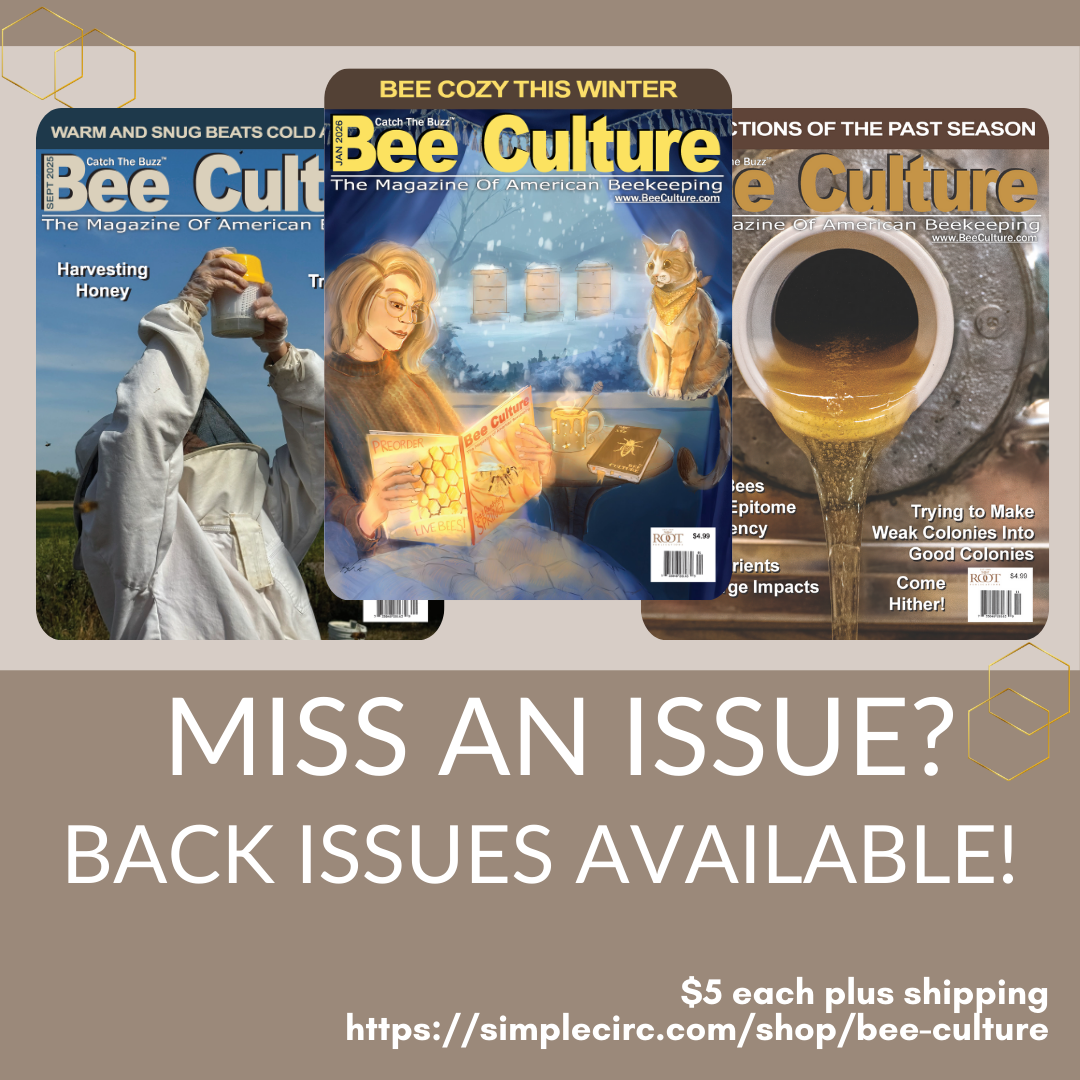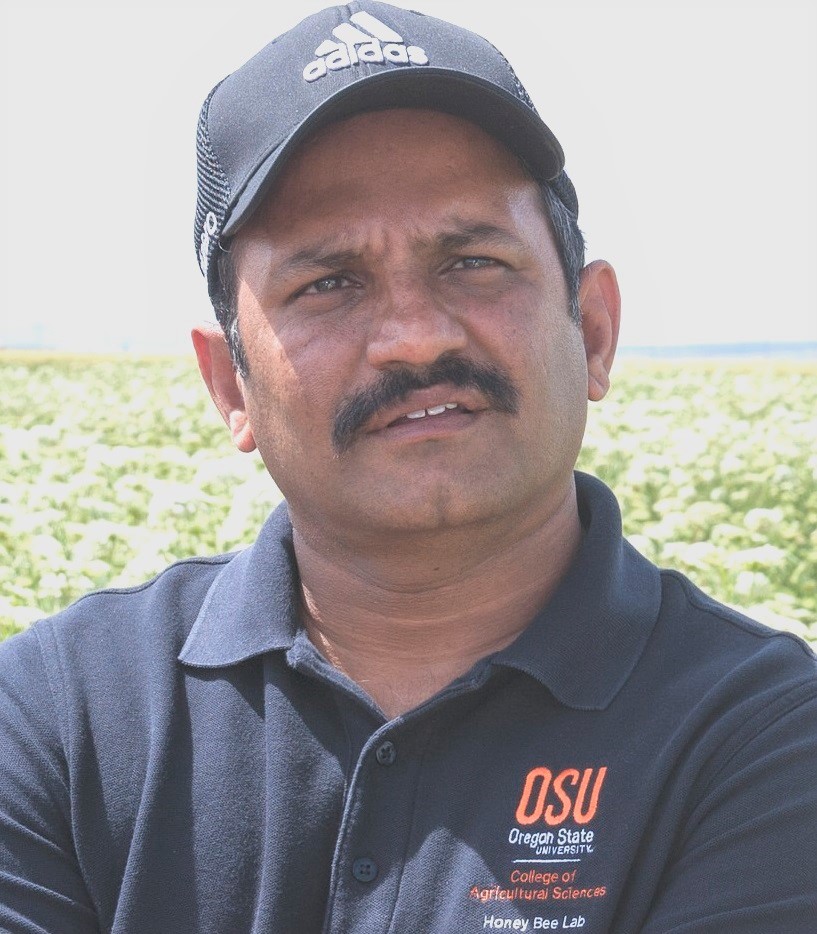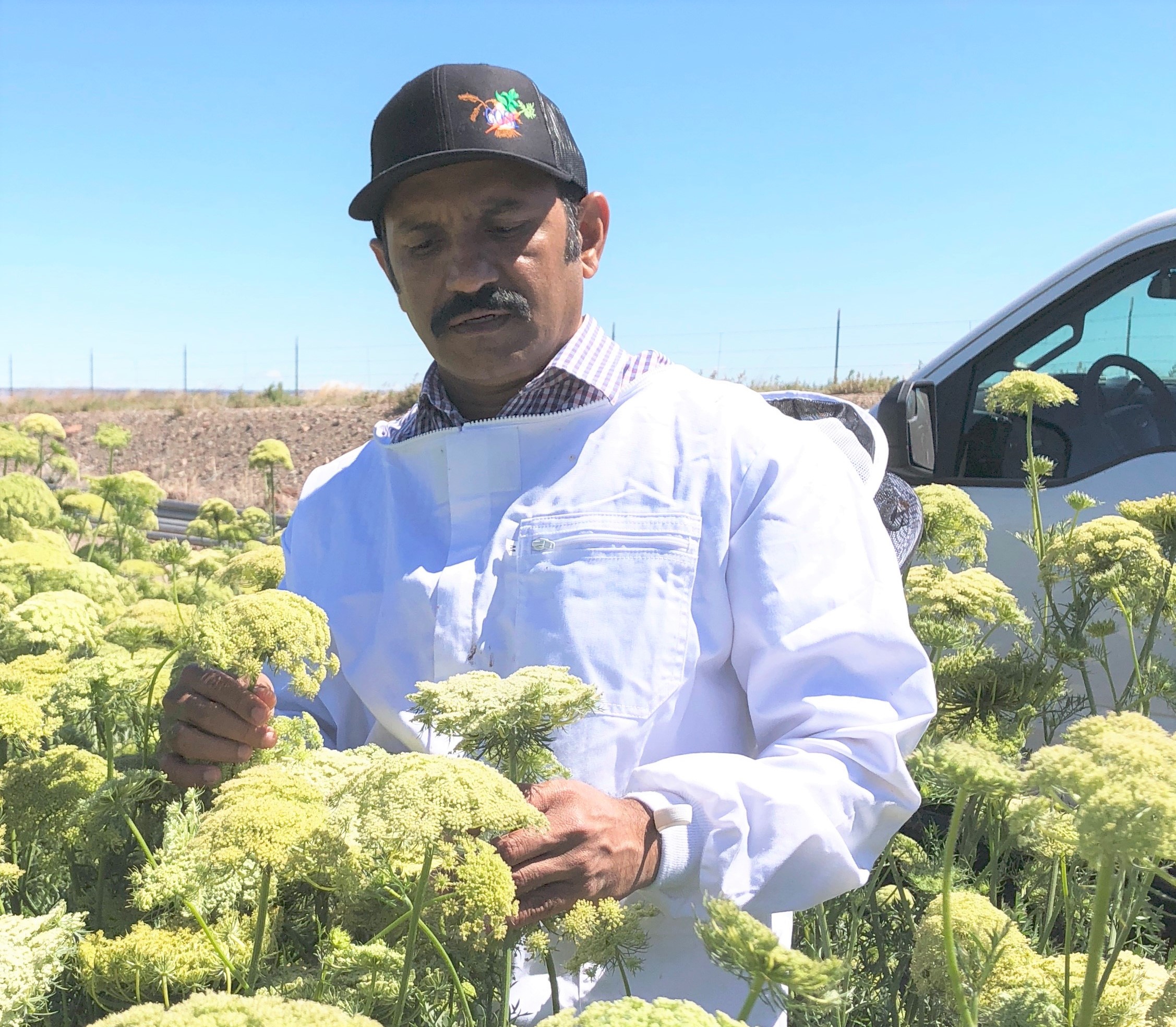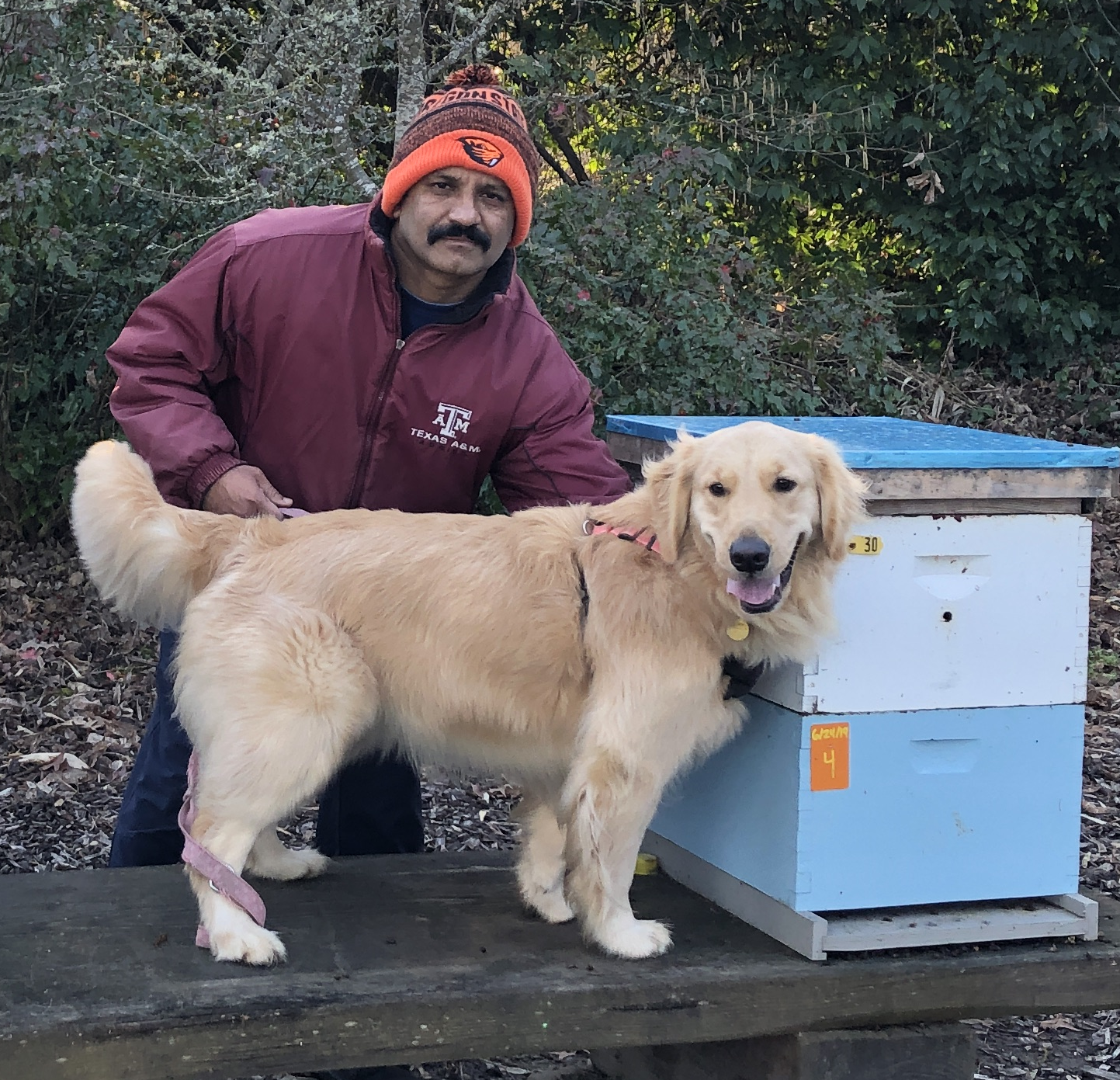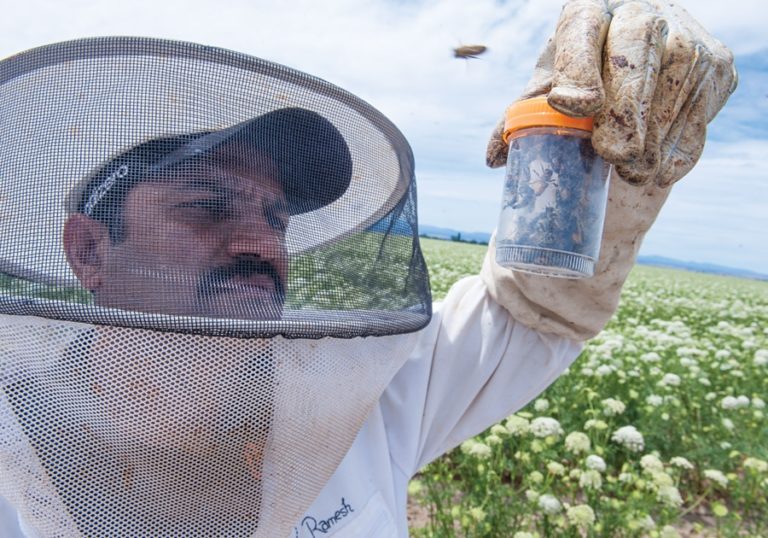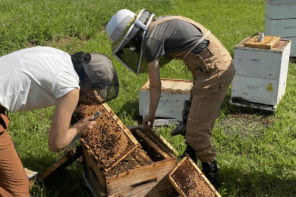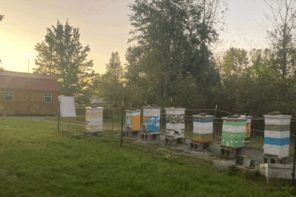An Interview with Oregon’s Dr. Ramesh Sagili
Dewey Caron
Oregon State University’s (OSU) bee position dates back to 1919. Herman Scullen was hired so OSU would have a “bee man” to offer beekeeping to the anticipated surge of WWI veterans returning to what was Oregon Agriculture College. He retired in 1953. The bee position remained unfilled until Dr. Michael Burgett was hired in 1974. His position was a result of the creation of a higher education budget line item of the 1973 state legislative session directing OSU to hire an apiculturist. This was the culmination of a long standing, on-going, lobbying effort of agriculturalists, beekeepers and the Oregon State Beekeepers Association.
Mike would remain Oregon’s Bee Doc until the University needed to downsize. As senior faculty, Mike was offered a generous retirement package, so he officially retired in January 2003. Unofficially he was at his bee lab the next day, pretty much continuing what he had been doing prior to “retirement”. In fact, today you can find Mike most days still in a University lab, unless he is in the field doing research.
While a faculty member, Mike had established a unique teaching/research apiary on unused land on the edge of campus adjacent to Oak Creek, a small campus stream. When the OSU Entomology Department was merged a decade ago, Burgett “saved” his apiary by joining it to the Horticulture department. Today the apiary continues as part of the Oak Creek Center for Urban Horticulture and Bees.
Following his retirement, the Oregon beekeepers once again sought legislative help in obtaining an apiculture position at OSU. An endowment was established to solicit donations and as the funding grew over $300,000, the Legislature again stepped up by funding a two year fixed term apiculture research and extension position. A national search led to hiring of Dr. Ramesh Sagili.
Dr. Sagili earned both Bachelor and Masters degrees in the mid-1990s from Andhra Pradesh Agricultural University (renamed as Acharya N.G. Ranga Agricultural University in 1996), one of the largest Agricultural Universities in India. It features multi-disciplinary programs with emphasis on outreach to farmers. As part of the curriculum, students are required to work directly with farmers. This program called RAWEP (Rural Agricultural Work Experience Program) mandates direct stakeholder contact and basic, practical training for students who are placed directly with farmers during their degree programs.
The Bachelors in Agricultural Sciences degree program includes all aspects of agriculture including entomology. Ramesh said he liked the entomology experience the best. He recalls an earlier experience when on visits to his grandparents’ farm he observed and helped his grandfather pollinate hybrid sunflowers by hand. His grandfather explained there were not enough bees in the region to properly accomplish pollen transfer, so humans had to transfer the pollen.
After finishing his masters, Ramesh investigated Centers in India for apiculture education. He found they were designed to teach beekeepers and not set up to conduct advanced bee research. So, in communication with friends, he investigated the possibility of coming to the U.S. to continue his studies. He found a graduate assistantship at Texas A&M University, one of the largest entomological graduate programs among U.S. Universities. Upon acceptance, he took an assistantship with Dr. Tanya Pankiw to pursue honey bee research. He started his PhD at Texas A&M in 2003, graduating in 2007.
His PhD research focused on examining effects of brood pheromone on worker foraging behavior and colony growth of honey bees. The research unraveled the appropriate blend of chemicals to stimulate foraging in honey bees. With Dr. Pankiw and students of the program, he has published several research papers detailing these ground-breaking studies. The University patented the chemical blend and a delivery system. A commercial brood pheromone was sold briefly by Mann Lake, marketed by a Canadian pheromone specialty company. The research remains an important demonstration of development and practical application of pheromone management of bees. The pheromone is no longer available for general use, but the blend of 10 chemicals is known and has been duplicated for other researchers.
Following completion of his degree, Dr Sagili remained at A&M for two years as post-doctoral researcher. Although he could have stayed longer at Texas, he began to investigate University faculty openings, including mine at University of Delaware. Oregon State was advertising for a two year fixed-term position in the Horticulture Department. He applied and was hired before Delaware could grab him.
Two years later the University reopened the apiculture position as a tenure-track, Assistant Professor rank. He was rehired after a national search from a highly qualified final pool of candidates. In 2017 he was promoted to Associate Professor and now is being evaluated for promotion to Professor by OSU faculty.
I started my interview asking him about his coming to Oregon from Texas.
Q: What attracted you to leave the postdoctoral position at Texas for a fixed two year term temporary position in Oregon?
A: After conducting multiple studies on brood pheromone of both basic and applied nature as a post-doc, I thought it was time to look for a more permanent position where I could expand my interests and pursue research to address more pressing problems related to honey bee health. The Oregon position was attractive since it was initiated by the beekeepers who had diligently pressured the Oregon legislature to reinstate the OSU honey bee program. I was aware that Oregon was a state with huge diversity of crops and many of those crops were dependent on honey bee pollination. I was ready to expand my research and extension efforts in Oregon.
Q: When beginning a new position in a different region of the U.S. what did you do to determine what aspects of beekeeping to investigate?
A: I initially arranged a series of meetings with stakeholders. I talked extensively with both beekeepers (commercial beekeeping was identified as the position priority) and farmers who were dependent on honey bees. The beekeepers identified three major aspects where research was needed, varroa mite control (at this time Apistan resistance was becoming widespread), bee nutrition and pesticides. The grower groups identified areas where they needed answers as to why the yields were low in certain crops. They wanted to know if poor yields/seed production was due to lack of adequate pollination or poor plant attractiveness to bees. This was especially the case with hybrid carrot seed production in the dessert area east of the Cascades.
Dr Sagili describes his current program at OSU as a three-part related approach to sustainability in apiculture and pollination. The effort includes both a basic and applied approach. The three major areas of research are: (1) honey bee health (2) honey bee nutrition and (3) honey bee pollination. A majority of the research projects are collaborative efforts, involving stakeholders (beekeepers, growers, general public interested in bees), OSU colleagues and collaborators from other universities, nationally and internationally. His work has achieved international recognition.
In 2016 Dr. Priyadarshini Chakrabarti, whom we know as Priya, joined the OSU Honey Bee Lab as a post-doctoral researcher. Ramesh enticed her to Oregon from India, where she was conducting top-notch research with Asian honey bees at the University of Calcutta. They have subsequently established a significant collaboration in bee nutrition.
They cooperated in securing a $500,000 USDA NIFA (National Institute of Food and Agriculture) grant to investigate several aspects of bee nutrition. A portion of the OSU grant will now be shared with Mississippi State University where Priya has started as Assistant Professor. The grant will support comprehensive analysis of both macronutrients and micronutrients in pollens available to bees, using techniques developed by Priya and Ramesh. They will build a database of nutritional composition of pollens from different plant sources available to bees. The proposal calls for determining nutritional values of more than 100 bee-pollinated crops, including native plants and commonly used ornamental plants. Both of them plan to recruit graduate students to work on this new endeavor.
A unique aspect of the grant will be to gather as wide a range of specific pollens as might be possible. For this analysis they will recruit a team of volunteer citizen scientists to assist in pollen collection. Since honey bees have floral fidelity, meaning honey bees forage on one specific flower species during each foraging trip, they will ask individuals to collect honey bee pollen foragers on target plant species to obtain source-pure pollen for analysis. The collection will not involve killing foragers – bees will be immobilized in a freezer and released after pollen is removed. If interested first contact Dr. Sagili at ramesh.sagili@oregonstate.edu. The pollen collections themselves will not begin until next year (2022 Spring).
Another aspect of the study will examine the impacts of certain fungicides – called sterol biosynthesis inhibitors (SBI) on the bee diet. Pollen sterols are a type of lipid that bees require for their development and growth which they cannot synthesize but must obtain from their diet. Priya and Ramesh have looked at the major plant sterols and their impact on bee nutrition. The grant funds will allow them to examine if the use of certain fungicides could compromise the quality of pollen that constitutes part of the bee diet.
Befitting his accomplishments, Ramesh has been the recipient of several awards. In 2019 he was recognized for Excellence in Post-Doctoral Mentoring by OSU and the year before for his excellence in Outreach and Engagement. Earlier he was recognized as an Outstanding Young Faculty and for an Excellence Award for his leadership in the Oregon Master Beekeeper program. The Entomological Society of America, Pacific Branch, recognized him for his research excellence in their section of Physiology, Biochemistry & Toxicology in 2017, and the Eastern Apicultural Society presented their J. I. Hambleton Award for Research Excellence in Apiculture the same year at their Annual meeting in Delaware. The Oregon State Beekeepers Association has also recognized him with an Honorary Lifetime Membership.
Q: I finished my interview by asking Dr. Sagili how moving from a fixed term position to a permanently funded University position had changed his research emphasis?
A: I continue to dialogue with beekeepers, including additionally backyard hobbyists. My effort now allows me to have a long-term vision and focus on longer-term research projects on bee nutrition and varroa control. I can now do some more basic research while continuing to directly address some of the beekeeper concerns with applied shorter-term projects.
As regard to pollination, we have been able to look at blueberry, an emerging major crop in Oregon. Colonies moved to blueberry seem to become stressed and exhibit higher EFB disease expression. We are testing several hypotheses to resolve this issue including examining the role of poor nutrition and fungicides in incidence and prevalence of EFB.
Q: So what is a more basic approach to bee nutrition?
A: The area of bee nutrition has been under investigated. The USDA did some decent work on bee nutrition in the 1970s and 1980s at Beltsville under your PhD student Elton Herbert but following his sudden death the studies were discontinued. The Tucson Bee lab has hired researchers and have nutritional studies underway. We have barely scratched the surface in terms of understanding nutritional requirements of bees. Our newest USDA NIFA grant funding will help us explore the most important sources of pollen for bees and build a nutritional composition database of those pollens that might be most critical. We are also investigating the optimal requirement of micronutrients for bees (e.g., sterols). We have several aspects of our nutritional studies completed or in pilot project status that might be revealing.
Q: The Oregon bee position includes extension as well as research. How important is that for a fulfilling bee lab program?
A: I believe that research and extension go hand in hand and are complementary. Having both research and extension has allowed me to understand the immediate needs and priorities of the stakeholders (beekeepers and farmers) and set up my research objectives accordingly. I started talking to beekeepers and farmers when I started my position and I continue those dialogues I give numerous presentations, visit apiaries and maintain regular contact with my stakeholders. The pandemic has limited the amount of direct contact since last year, but we organized several zoom sessions for the beekeepers to keep them and conversely us updated. We also offer pest and disease diagnostic workshops for beekeepers and veterinarians. I constantly learn and keep current by talking with beekeepers and farmers who always have great insights.
Q: What do you feel are the greatest impacts of the OSU bee lab’s extension program?
A: To cater to the needs of new beekeepers, we initiated and developed a unique Master Beekeeper Program in Oregon in collaboration with Oregon State Beekeepers Association. The Oregon Master Beekeepers program has taken the training of new beekeepers to a new level. We continually seek to refine our program. With the pandemic, we developed an option that delays mentor involvement, but still provides quality introduction to beekeeping. The program matches new beekeepers with mentors and offers beekeeping instruction (now virtual due to the pandemic). We have recently initiated bee mentor training to standardize the program. We will soon incorporate education on bee sting reactions for our mentors.
We have collaborated with the Oregon Department of Agriculture pesticide division to train their field personnel on how to recognize and distinguish colony losses from pests, diseases, starvation versus potential pesticide damage or kill. We are also training veterinarians in the state on diagnosis of honey bee brood diseases, so that Oregon beekeepers that need antibiotics have access to trained veterinarians to obtain prescriptions.
We have published several useful extension publications on several timely topics during the past decade that include publications on Asian Giant Hornet, Enterprise budgeting for commercial beekeeping, evaluating hives for pollination, how to establish nucleus hives, and methods for varroa sampling. Our publication and an app on how to reduce bee poisoning from pesticides (PNW 591) has become a major source for information on pesticides for both farmers and beekeepers. We have also prepared an informative flyer on small hive beetle, something that appears to be increasingly of concern in honey house management and for beekeepers managing weaker colonies.
Q: You have even taken on some teaching of beekeeping? How do you integrate the classroom and e-campus teaching into your research and extension efforts?
A: It is important to expose our students who will be the future farmers of Oregon to honey bees. We have over 20 crops common in Oregon that require or benefit from bee pollination. Farmers and beekeepers need to communicate with each other to insure adequate crop pollination. Although only a lecture course, I take the students to our teaching apiary to give them real-time exposure to bees. I started teaching in the winter quarter as it was less disruptive to our research, but later switched to teaching in spring term due to overwhelming demand from students to teach in spring. Our e-campus (distance learning) course has become a popular option for students across the nation and abroad. And I might add that I am always looking for students to assist with our research projects. If they have taken my course, I know they have been exposed to the basics of beekeeping and hence need less training when assisting with research.
Dr Sagili represents the latest in a series of Bee Doctors on the faculty at Oregon State University. The program is robust, very much alive and works well in conjunction with and for the benefit of beekeepers and those who benefit from bees in Oregon and across the nation.



